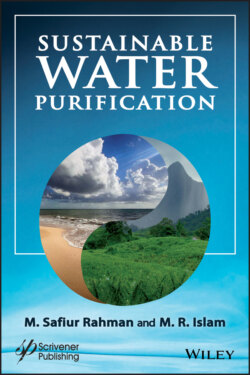Читать книгу Sustainable Water Purification - M. R. Islam - Страница 15
1.4 Insufficiency in Water Purification Processes
ОглавлениеVast majority of water contamination is due to industrial waste, which contain synthetic (uunatural) chemicals, which emerge from the industrial applications. The contaminated water, which contain synthetic chemical, biological, organic waste and other contaminants, suspended solids, and gases are treated in order to remove the undesired components in the water stream. It is routine that water is first disinfected in order to remove bacteria and organic organisms, algae, etc. Although most water is purified for human consumption, the purification agents are invariably synthetic chemicals, which are toxic to the environment and to humans. In addition, water is subject to chlorination, fluoridisation, and others with the pretext of maintaining levels of chemicals under certain pre-determined values. Even for commercial applications, synthetic chemicals are added in order to make the water usable. For medical and pharmaceutical purposes, the purity of water is increased by exposing water to rigorous purification processes, which invariably use one or more of the following techniques:
filtration
sedimentation
distillation
chemical processes
electromagnetic and other form of irradiation (such as ultraviolet light)
Although the above processes reduce the concentration of suspended particles, parasites, bacteria, algae, viruses, and fungi as well as reduce the concentration of a range of dissolved and particulate matters, the water stream picks of parts of the chemicals used to purify and as long as the concentration is smaller than the regulatory body’s requirement there remains no way to determine their long-term impact. Jaspal and Malvya (2020) reviewed major water purification composites. The use of such composites is considered to be the latest technology in water purification. The use of different types of composites ranges from nanocomposites, activated charcoal composites, polymer composites, oxide-based composites, hybrid composites, and biosorbent composites, etc. Water purification takes place via adsorption process. These composites have been explored for treating or elimination of various hazardous substances like heavy metal species, different classes of colored contaminants (dyes), several organic and inorganic pollutants from wastewater. The most significant advantage of the use of composites is the combination of properties of two materials into one for specific applications. In the current scenario, composites have gained popularity in various fields such as constructional, aeronautical, vehicular, biomedical, industrial etc. (Mahajan and Aher, 2012). The use of the said materials in wastewater treatment is becoming a research focus for many. The properties offered by composites include specific strength, processability, and design flexibility. While these composites successfully eliminated Zn2+, Ni2+, Cu2+, Pb2+, Hg, etc., each ion is replaced with another component from the adsorbing chemicals that are used in the process. Each of these composites would be considered unsustainable if environmental sustainability were considered (Khan and Islam, 2016). Figure 1.4 shows how chemicals are removed from the contaminated water only to be replaced with toxins, which arise from the purification process.
Figure 1.4 Water purification process.
The above purification process does not include the impact of using unnatural radiation (e.g. ultraviolet). Although conventional analysis makes it impossible to identify the impact, let alone quantify it, Islam and Khan (2019) Islam et al. (2016) have shown that the effluent water would carry the signature of each unnatural process (energy or mass) used during the purification cycle.
